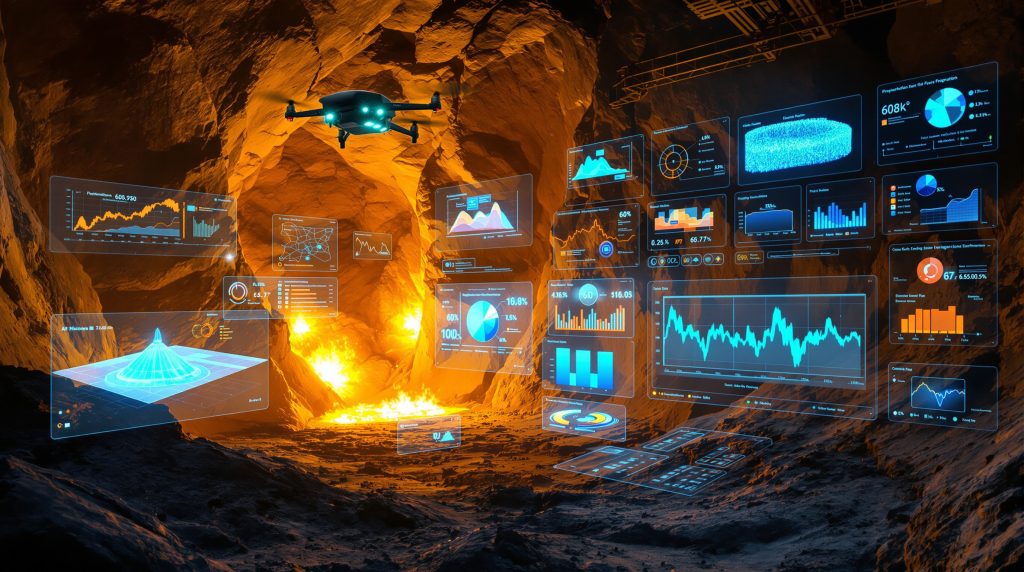Revolutionising Mining Operations Through Strategic AI Integration
The mining industry stands at a technological crossroads where traditional blasting methods meet cutting-edge artificial intelligence capabilities. The BME and Strayos alliance optimises blasting with AI-driven insights, representing a fundamental shift toward data-driven mining operations. This partnership combines decades of explosives expertise with advanced machine learning algorithms to create comprehensive solutions that address the sector's most pressing challenges.
Modern mining operations face intense pressure to maximise productivity while maintaining stringent safety standards and environmental compliance. Traditional blasting approaches, while proven effective over decades, often depend on experience-based decision-making that can result in inconsistent fragmentation patterns. Furthermore, these methods may lead to excessive ground vibration and suboptimal downstream processing outcomes.
The integration of AI-powered analytics into blast design represents a paradigm transformation toward predictive modelling and real-time optimisation. The new XPLOSMART™ platform demonstrates how strategic partnerships can leverage complementary technologies to deliver enhanced operational value. This AI-enabled software suite provides integrated mine-to-mill solutions that empower mining operations with geospatial analysis tools and intelligent modelling capabilities across unified data platforms.
Advanced Image Processing Technologies Transform Blast Design Accuracy
Three-dimensional photogrammetry has emerged as a cornerstone technology for modern blast optimisation systems. High-resolution aerial imagery captures detailed bench topography with unprecedented precision, creating comprehensive digital models that reveal geological variations invisible to conventional surveying methods. These detailed models provide blast engineers with sophisticated visualisation tools that enable accurate burden and spacing calculations based on actual field conditions.
The integration of drone-based fragmentation analysis represents another significant advancement in post-blast assessment capabilities. Traditional fragmentation measurement techniques required manual sampling methods that were both time-consuming and often statistically unreliable. In addition, AI transforming drilling and blasting operations now delivers automated fragmentation analysis within hours of detonation, providing immediate feedback on blast performance metrics.
Key technological capabilities include:
- Automated measurement of fragment size distribution with statistical confidence intervals
- Real-time identification of oversize material requiring secondary breaking operations
- Detection of potential safety hazards including unstable highwall conditions
- Quantitative analysis of muckpile characteristics for optimised loading operations
- Integration with existing mine planning and fleet management systems
Rock mass analysis powered by artificial intelligence provides deeper insights into geological formation characteristics that directly impact blast design decisions. These systems analyse drilling parameters, geological surveys, and historical performance data to identify patterns and correlations. Consequently, 3D geological modelling techniques help human operators identify patterns they might overlook during conventional planning processes.
Integrated Data Analytics Drive Mine-to-Mill Optimisation
Modern blast optimisation platforms consolidate multiple data streams into unified analytical frameworks that provide comprehensive operational intelligence. Geological surveys, drilling logs, explosive performance data, and mill throughput statistics combine to create holistic understanding. This integrated approach enables mining operations to optimise the entire value chain rather than individual components in isolation.
Smart drill analytics represent a significant advancement in understanding subsurface conditions before blast design implementation. Measure-while-drilling (MWD) systems collect real-time data on rock hardness, fracturing patterns, and geological transitions. This information feeds into predictive algorithms that optimise blast designs for specific geological conditions, reflecting the broader industry evolution trends towards technological integration.
Critical data integration components:
| Data Source | Application | Impact on Operations |
|---|---|---|
| MWD Parameters | Real-time geology mapping | 15-20% improvement in burden accuracy |
| Fragmentation Analysis | Post-blast optimisation | 25-30% reduction in secondary breaking |
| Mill Throughput Data | Mine-to-mill correlation | 12-18% increase in processing efficiency |
| Environmental Monitoring | Compliance management | 95%+ automated regulatory reporting |
| Geotechnical Analysis | Highwall stability | 40-50% reduction in safety incidents |
The platform's ability to provide insight into operational pain points both upstream and downstream of the blasting circuit enables comprehensive optimisation strategies. With implementations across over 5,000 sites globally, the proven track record demonstrates scalability across diverse geological and operational conditions.
Machine learning algorithms analyse historical performance datasets to identify subtle patterns and correlations that traditional statistical methods might miss. These insights enable predictive modelling that forecasts blast outcomes based on specific design parameters, geological conditions, and operational constraints. However, the result is optimisation based on quantitative analysis rather than trial-and-error approaches.
Enhanced Safety Protocols Through Predictive Analytics
Ground vibration and flyrock represent significant safety and environmental risks in blasting operations that require sophisticated monitoring and mitigation strategies. AI-powered systems analyse geological conditions, charge configurations, and timing sequences to minimise these hazards while maintaining fragmentation objectives. Predictive algorithms identify potentially problematic blast designs before implementation, reducing risks to nearby structures and personnel safety.
Automated compliance monitoring addresses the evolving regulatory landscape governing mining operations. Environmental regulations continue to become more stringent, requiring sophisticated tracking and reporting capabilities that manual systems cannot efficiently provide. AI-enabled platforms automatically monitor blast performance against regulatory limits, generating compliance documentation and alerting operators to potential violations before they occur.
Advanced safety enhancement features:
- Real-time vibration prediction with geological modelling integration
- Automated flyrock trajectory analysis using ballistic modelling algorithms
- Highwall stability assessment through geotechnical AI analysis
- Emergency response protocol integration with mine communication systems
- Environmental impact monitoring with automated regulatory reporting
The integration of 24/7 customer service support networks ensures continuous operational assistance across different time zones and operational schedules. This comprehensive support structure addresses the global nature of mining operations where equipment downtime can result in significant financial impacts.
Geotechnical analysis capabilities extend beyond traditional blast design to encompass broader mine safety considerations. AI algorithms analyse highwall stability, ore body movement patterns, and haul road intelligence to provide comprehensive risk assessment across mining operations. This holistic approach to safety management represents a significant advancement over compartmentalised traditional methods.
Quantifiable Operational Benefits and ROI Metrics
Mining operations implementing AI-driven blast optimisation typically report substantial improvements across multiple key performance indicators. Consistent fragmentation quality reduces crusher wear rates, improves mill throughput capacity, and minimises secondary breaking requirements. These operational efficiencies translate directly into measurable cost savings and increased production capacity, supporting broader sustainability transformation initiatives.
The modular nature of modern optimisation platforms accommodates operations ranging from small quarries to large-scale mining complexes. This scalability ensures organisations can implement solutions appropriate to their operational scale and budget constraints while maintaining clear upgrade pathways for future technological expansion.
Typical operational improvements observed:
- Fragmentation Consistency: 15-25% reduction in size variation leading to improved crusher efficiency
- Explosive Utilisation: 10-20% reduction in consumption through precise charge calculations
- Mill Throughput: 8-15% increase in processing rates due to optimal fragmentation
- Secondary Breaking: 30-50% reduction in requirements lowering operational costs
- Environmental Compliance: 95%+ automated monitoring accuracy reducing regulatory risks
Resource utilisation optimisation extends beyond explosive consumption to encompass comprehensive operational efficiency improvements. AI systems calculate precise charge requirements based on actual geological conditions rather than conservative estimates, reducing material costs while improving blast effectiveness. This targeted approach delivers measurable return on investment through reduced consumption and enhanced performance metrics.
For instance, the platform's ability to integrate automation technologies represents a significant advancement toward autonomous mining operations. Doing more with less has always been a fundamental objective in mining economics, and AI-enabled technologies paired with premium blasting solutions provide pathways to achieve these efficiency gains.
Future-Focused Technology Integration and Expansion
The convergence of AI analytics with robotic systems promises fully autonomous blast execution capabilities in the near future. Advanced systems may automatically adjust charge placement, modify timing sequences, and optimise detonation parameters in real-time. This level of automation represents the next evolutionary step in mining technology development, as demonstrated by strategic partnerships between established mining companies and technology innovators.
Digital twinning technology creates virtual representations of mining operations that enable comprehensive scenario modelling and optimisation testing. These digital models incorporate real-time data feeds from multiple sources to provide accurate simulations of blast performance under varying conditions. Engineers can test different design approaches virtually before implementation, reducing operational risks and improving outcomes.
Emerging technological developments:
- Internet of Things (IoT) sensor networks providing continuous geological monitoring
- Edge computing capabilities enabling real-time processing at mining sites
- Augmented reality visualisation tools for immersive blast design experiences
- Blockchain-based compliance tracking ensuring transparent regulatory reporting
- Machine learning algorithms with enhanced predictive accuracy through expanded datasets
Infrastructure optimisation capabilities extend the platform's value proposition beyond traditional blasting applications. Cost savings achieved through improved efficiency enable mining operations to invest in additional technological upgrades, creating positive feedback loops that accelerate overall operational improvement.
The alliance between established mining companies and AI technology leaders represents an excellent strategic fit with significant growth opportunities. These collaboration avenues include digitisation initiatives, digital twinning implementations, AI technology deployment, and automation integration projects that deliver comprehensive operational benefits across multiple development streams.
Transforming Mine-to-Mill Value Chain Optimisation
The integration of artificial intelligence into mining blast operations represents more than technological advancement; it constitutes a fundamental transformation toward predictive, data-driven operational excellence. By combining advanced image processing capabilities, comprehensive data analytics, and sophisticated predictive modelling, these systems deliver measurable improvements in safety performance, operational efficiency, and environmental compliance.
Mining operations that embrace AI-powered blast optimisation position themselves to capitalise on competitive advantages that extend throughout the entire mine-to-mill value chain. The convergence of multiple advanced technologies creates synergistic benefits that amplify individual technological contributions, resulting in comprehensive operational improvements that traditional methods cannot achieve.
"The performance improvements and ROI metrics mentioned in this article are based on industry case studies and may vary significantly depending on geological conditions, operational parameters, and implementation approaches. Mining operations should conduct thorough feasibility assessments before implementing new technologies."
As the mining industry continues evolving toward greater automation and intelligence integration, organisations investing in comprehensive blast optimisation platforms establish the technological foundation necessary for sustained competitive advantage. The BME and Strayos alliance optimises blasting with AI-driven insights demonstrates how strategic partnerships between traditional mining expertise and cutting-edge technology companies can deliver transformative operational benefits.
The scope for technical services integration and shared resource utilisation provides platforms for continual innovation that expedite global growth initiatives and strategic expansion projects. These collaborative frameworks ensure that mining operations can access the latest technological developments while maintaining operational continuity and regulatory compliance in increasingly complex operational environments.
Want to Capitalise on AI-Driven Mining Discoveries?
Discovery Alert's proprietary Discovery IQ model delivers real-time notifications on significant ASX mineral discoveries, including mining technology breakthroughs and AI integration successes that drive substantial market movements. Explore historic examples of major mining discoveries that have generated exceptional returns for early investors, or begin your 30-day free trial today to position yourself ahead of the market.




